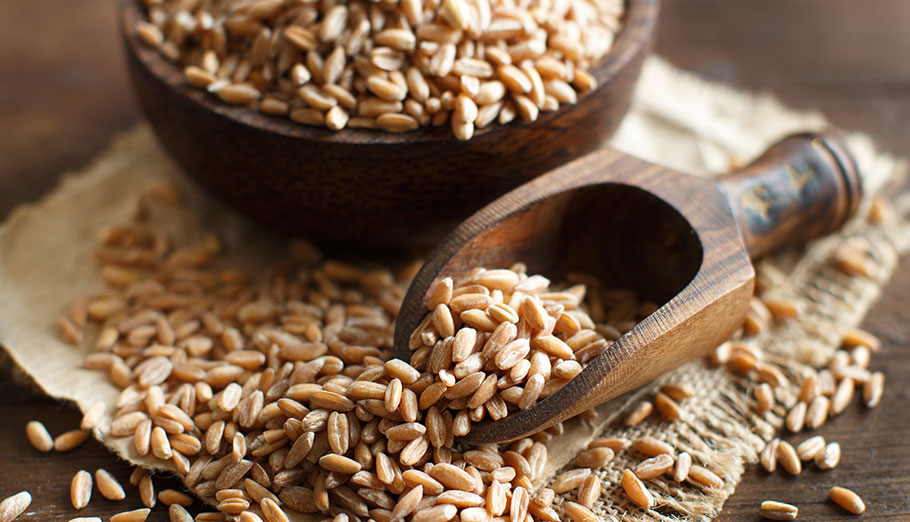Farro

Overview (Has Gluten)
Farro (also known as Emmer wheat) is an ancient grain believed to have originated in the Fertile Crescent, a semi-circular region encompassing Iraq, Israel, Jordan, Lebanon, and Syria. Grains of farro have been discovered in settlements dating to 17,000 BC. However, many associate the grain most strongly with Italy, largely because the word “farro” is derived from Italian Latin for a group of three related wheats: spelt, emmer, and einkorn. These three species are also known as farro grande, farro medio and farro piccolo.
Although some grain suppliers sell the spelt variety as farro, aficionados of farro consider the emmer variety (farro medio or Triticum dicoccum) to be the true farro. The difference lies in the genetics of these two strains. Emmer, having four chromosomes, is a more primitive wheat than spelt, which has six chromosomes. According to some, the extra chromosomes equate to more allergenic compounds. Also, there are differences in how these two strains are cooked and in their taste.
Nutrition
Farro is recognized as a healthy grain. It is notable for its high fiber content and as a good source of protein and Vitamin B3 and a great source of magnesium. It is also high in antioxidants, which can be helpful in warding off degenerative diseases and cardiovascular problems.
Note: Weight of a cup (or partial cup) of flour varies depending upon whether it is lightly sprinkled into a measuring cup or compacted. Most recipe measurements are based on sifted flour as a way to arrive at more uniform measurement.
Farro Flour with a Home Flour Mill
Farro has become increasingly popular throughout the United States over the past decade and can be found in most grocery stores now. Most farro sold in stores has been pearled (polished to remove the outer layer or bran) to reduce the time it takes to cook. If you can find unpearled farro, you will benefit from a grain which has the bran, germ, and endosperm all intact.
Because farro is a type of wheat, it can easily be milled by most home flour mills. Be aware, however, that unpearled farro will be harder to grind than pearled farro. You may want to dehydrate unpearled farro at 95-108 degrees for 24 hours prior to grinding for faster cleanup and a lower grinding temperature. This is also a factor to consider if you are using a hand operated flour mill.
Gluten Content & Allergen Information
As part of the wheat family, farro contains gluten and is not suitable for anyone with Celiac disease or gluten intolerance.
Substitutes and Alternatives to Farro Flour
Virtually any wheat flour is a fine alternative to farro flour. For a gluten-free alternative, try brown rice flour or quinoa flour.
Nutrition Facts
| Serving Size | 1 Cup |
| Calories | 800 |
| Total Fat 6g | 8% |
| Cholesterol 0mg | 0% |
| Sodium 0mg | 0% |
| Carbohydrates 148g | 50% |
| Dietary Fiber 28g | 94% |
| Total Sugars 0g |
| Protein 28g |
| Vitamin D 0mcg | 0% |
| Calcium 2mg | 1% |
| Iron 3mg | 17% |
| Potassium 0mg | 0% |
* The % Daily Value (DV) tells you how much a nutrient in a serving of food contributes to a daily diet. 2,000 calories a day is used for general nutrition advice.
Diet Compatibility
Paleo Diet
The Paleo Diet seeks to emulate the hunter-gatherer diet of our stone-age ancestors. The emphasis is on wild plants and meats similar to what ancient man would have consumed. As such, dairy products, refined sugar and processed oils are off limits. While many Paleo Diet followers also avoid grains, there is ample archaeological evidence to show that grains were part of Paleolithic era man’s diet.
Compatibility with Farro Flour:
Not Compatible, as there is no evidence of primitive man eating farro.

Mediterranean Diet
This diet seeks to emulate the diets of those living along the Mediterranean coast, with an emphasis on fresh fruits and vegetables, seafood/fish at least twice a week, limited servings of poultry, and only occasional sweets and red meat.
Compatibility with Farro Flour:
Compatible

Gluten-Free Diet
As the name suggests, the gluten-free diet eliminates all foods with gluten. Although most of those on a gluten-free diet are on it out of necessity—either due to severe wheat allergies or Celiac disease—many have embraced a gluten-free diet as being healthier.
Compatibility with Farro Flour:
Not Compatible

Macrobiotic Diet
Although there are many versions of macrobiotic diets, the common thread is that they emphasize natural, whole foods, grown locally and organically. Whole grains, vegetables, legumes, fruits, seeds and nuts, and occasional seafood are all integral to the diet. Red meats, dairy, poultry, eggs and processed foods are off the menu.
Compatibility with Farro Flour:
Compatible in Small Amounts

Acid Alkaline Diet
This diet aims to restore the slightly alkaline state of the body, which is believed to be ideal. By focusing on a diet high in vegetables, fruits, sprouted grains, lentils, almonds and soy products, the goal is to have a balance of 80% alkalizing foods and 20% acid forming foods.
Compatibility with Farro Flour:
Compatible – Farro Flour is considered to be slightly acidic

Low-Carb Diet
As the name suggests, this diet focuses on reducing carbohydrates in the diet to lose weight. The theory is that by staying away from high-carb foods like pasta and bread and eating low carb, high fiber vegetables and fruits instead, your body will go into ketosis and you will lose weight. This diet is sometimes referred to as a ketogenic diet.
Compatibility with Farro Flour:
Compatible in Limited Quantities

Atkins Diet
The Atkins Diet is a historically popular low carb diet, instructing dieters not to worry about their calories but to monitor and minimize their intake of sugar and carbohydrates. According to Dr. Atkins, depriving the body of its primary energy sources causes the body to burn fat.
Compatibility with Farro Flour:
Compatible in Limited Quantities

“We love the mill! We use it every day for things from bread, to pastry and it is phenomenal. The biggest selling point for me was the fineness since that would mean we can really do some great pastry with it in addition to bread. It definitely has been great!"
BEN FROM NORTH CAROLINA

